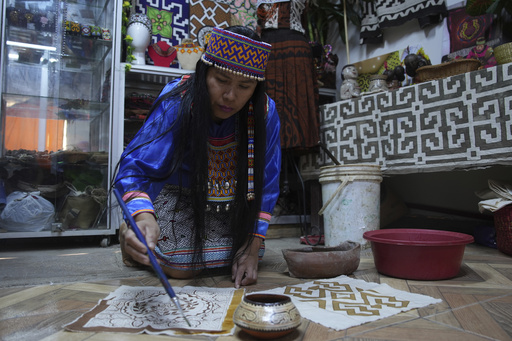
LIMA, Peru — Sadith Silvano creates her artistic works inspired by ancient melodies. With the brush in one hand and her focus on the fabric, the Peruvian artisan paints while singing, allowing her ancestors’ voices to resonate through her creation.
“When we immerse ourselves in painting, we draw inspiration from music, forming a connection with nature and honoring our elders,” noted Silvano, 36, who relocated to Lima from her native Paoyhan, a Shipibo-Konibo Indigenous community in the Amazon, two decades ago.
Silvano described her pieces as sacred, stating, “We infuse our work with the energy derived from our songs.” The Shipibo-Konibo community, which numbers close to 33,000 according to official statistics, has seen many of its members migrate to urban settings, such as Cantagallo, a neighborhood in Lima where Silvano now resides.
The hand-painted textiles created by Silvano, known as “kené,” have slowly garnered appreciation, with the Peruvian government designating them as part of the nation’s “Cultural Heritage” in 2008. Each unique kené pattern reflects a craftswoman’s community, beliefs, and perspective on life.
“Each design embodies a narrative,” asserted Silvano, dressed in traditional attire, with a beaded garment adorning her head. “It is a distinctive way for a Shipibo woman to express herself.” Through generations, the skill of crafting these textiles has been passed down, intertwining the wisdom of nature with the knowledge imparted by the elders, connecting the younger generations to their ancestral lands.
Paoyhan, Silvano’s birthplace, is reachable by flight followed by a lengthy boat ride. In her hometown, most residents speak Shipibo as their primary language, while simple living practices abound, with no locks on doors and meals sourced straight from nature.
Adela Sampayo, a 48-year-old healer from Masisea, near Paoyhan, moved to Cantagallo in 2000, yet her healing abilities still reflect her Amazonian origins. “My mother treated me with traditional remedies from the time I was young,” Sampayo recalled, sitting cross-legged in her home where she offers ayahuasca and various healing solutions for those in physical or emotional distress.
“My mother introduced me to the strength of plants to bolster my resilience and ward off illness,” she explained, “and it is through those teachings that the spirit of plants began to thrive within me.” Like Silvano, she shares her worldview through textile arts—although her medium is embroidery rather than painting, with each thread conveying stories of home.
“Every plant has a spirit,” Sampayo emphasized, gesturing towards the embroidered foliage, “and the medicinal plants are divine gifts.” The motifs painted by Silvano also carry significant meanings. One design symbolizes pure love, another signifies a sage, and yet another portrays a serpent.
“Our relationship with the anaconda is especially sacred,” Silvano remarked. “It serves as our protector, akin to a deity that nurtures us with food and water.” Historically, she said, her community viewed the sun as their father, and the anacondas as the guardians. With the advent of colonization, new beliefs and the Catholic faith began to overshadow their Indigenous perspectives.
“Today, we embrace various religions, including Catholicism and evangelical beliefs, while still maintaining respect for our traditions,” said Silvano. Longing for the peace of her mountains and clear skies, she moved to Lima after her father sought a better future. Although life in Paoyhan was challenging, it shaped her resilience from an early age.
In the 1990s, communities in the Amazon were marred by violence from the Shining Path insurgency, alongside widespread poverty and gender inequality. Many Shipibo women learned to rise above their suffering through soulful music. “During challenging times, we overcome adversity through therapy: crafting, painting, and singing,” Silvano stated. “We have melodies that heal our spirits, and those that inspire happiness.”
Despite cultural expectations that often discourage Shipibo girls from pursuing education or financial independence, Silvano voiced that many are taught to prioritize marriage over self-empowerment. “The prevailing narrative suggests we endure, even through difficulty, as he is the father of our children. Deep down, we’re often hurting. So, we turn to song.”
The wisdom passed from mother to daughter reinforces that if a woman feels pain at home, she should grasp her cloth and brush, find solitude, and connect with her kené to paint while singing. “That is our form of healing,” shared Silvano. “Through our songs and kenés, we attain freedom.”
In the same workshop where she raises her two children, Delia Pizarro creates jewelry, also singing while she crafts colorful bird figurines from beads. “I was once quiet and didn’t express myself, but after encouragement from Olin, Sadith’s sister, I found my voice,” Pizarro reflected. “Now as a single mother, I feel confident and know how to advocate for myself.”
The artisanship of the Shipibo community is rich with varied designs, often depicting symbols such as anacondas—representing protection—and jaguars and herons, both of which are esteemed by their elders. Creating a Shipibo textile can take up to six weeks to complete, with materials sourced from the Amazon, including natural pigments and locally grown cotton. The black dye used by Silvano originates from a specific type of bark tree found in Paoyhan, and the mud used for setting colors is gathered from the Ucayali River.
“It brings me joy when a visitor leaves with a piece originating from our community,” Silvano expressed, carefully blessing one of her fresh textiles for a potential sale. She commented on the evolution of recognition for Shipibo crafts since she and her father arrived in Lima two decades ago. In Cantagallo, home to around 500 Shipibo families, many artisans are now successfully selling their creations.
“My art has empowered me and accompanied me throughout my journey,” Silvano concluded. “Thanks to the teachings of my mother, grandmother, and sisters, I possess a knowledge that has opened many doors.” Holding onto her textiles, she reiterated, “Here resides the essence of our children, our ancestral heritage, and our community. Here’s the inspiration drawn from our songs.”
